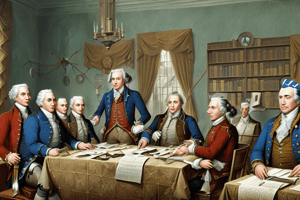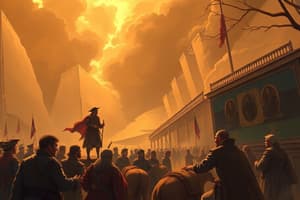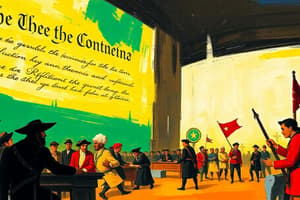Podcast
Questions and Answers
What led to the convening of the Constitutional Convention?
What led to the convening of the Constitutional Convention?
- The Federalist Papers
- The Bill of Rights
- The Northwest Ordinance of 1787
- Shays' Rebellion (correct)
What is the primary work of Congress?
What is the primary work of Congress?
- Enforce laws
- Interpret laws
- Make laws (correct)
- Confirm appointments
Which amendment guarantees the right to a speedy trial?
Which amendment guarantees the right to a speedy trial?
- 10th Amendment
- 6th Amendment (correct)
- 8th Amendment
- 4th Amendment
What was a major concern of those who opposed the Constitution?
What was a major concern of those who opposed the Constitution?
Which document was created to limit the power of the Federal Government?
Which document was created to limit the power of the Federal Government?
How many senators does each state have to balance representation?
How many senators does each state have to balance representation?
What powers are shared by both the federal and state governments?
What powers are shared by both the federal and state governments?
Which of the following is NOT a feature of the Federal system of government?
Which of the following is NOT a feature of the Federal system of government?
Flashcards are hidden until you start studying
Study Notes
Concerns after the American Revolution
- After the American Revolution, the Continental Congress feared that the rights for which the people fought would be lost.
The Northwest Ordinance of 1787
- The Northwest Ordinance of 1787 led to territories eventually becoming states.
Shays' Rebellion
- Shays' Rebellion was a significant event, as it contributed to the decision to hold a Constitutional Convention.
The "Father of the Constitution"
- James Madison, well-prepared to guide the convention, was dubbed the "Father of the Constitution".
The Constitutional Convention
- The Constitutional Convention delegates agreed on a representative government.
- The Great Compromise determined the representation in Congress.
- Those opposed to the Constitution were concerned about relinquishing state power for a more powerful union.
Federalism
- The US government is a federal system where power is shared between the Federal government and State governments.
The US Constitution
- The Constitution is structured into sections called articles.
- Each state has two senators to ensure the balance of rights for both small and large states.
- The primary duty of Congress is to create laws for the nation.
- The Executive branch lacks the authority to propose new taxes.
- The Supreme Court derives its power from Judicial Review.
- States can amend the Constitution with a three-quarters vote.
Powers of the Federal Government
- The US government and States have the power to levy taxes.
- International trade is not prohibited in a common market.
The Bill of Rights
- In 1788, several states required a list of citizens' rights (the Bill of Rights) to ratify the US Constitution.
- The objective of the Bill of Rights is to restrict the power of the Federal Government.
- The principle of the rule of law dictates that no one is above the law.
- Freedom of the Press ensures an informed public.
- The First Amendment does not protect property damage during a protest.
- Requiring a permit for protests is a violation of the rule of law.
The Influence of British Law
- Due to British law, the right to bear arms, the ban on quartering soldiers, and protection from unreasonable searches and seizures were established in the Bill of Rights.
The 6th Amendment
- The Sixth Amendment guarantees the right to a speedy trial.
Amendments Nine and Ten
- The Ninth and Tenth Amendments were added to maintain a balance of power and rights.
Studying That Suits You
Use AI to generate personalized quizzes and flashcards to suit your learning preferences.




